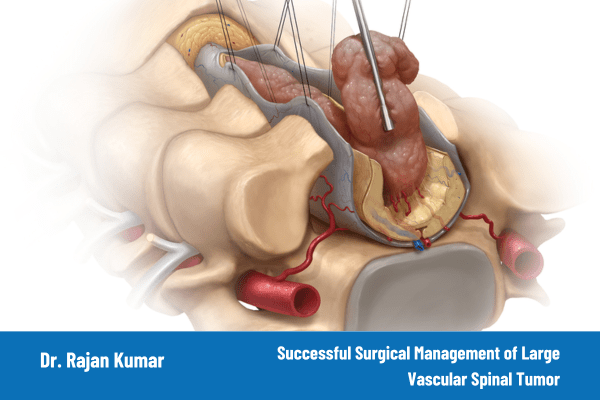Introduction: In the field of neurosurgery, the management of spinal tumors presents unique challenges, especially when dealing with large vascular tumors. In this case study, we will explore the successful surgical intervention of a large vascular spinal tumor by Dr. Rajan, a renowned consultant neurosurgeon. We will delve into the intricacies of the case, highlighting the surgical approach and post-operative care.
Case Presentation: A 45-year-old patient presented with progressively worsening back pain and lower limb weakness. Radiological investigations revealed a large vascular spinal tumor in the thoracic region, compressing the spinal cord and causing neurological deficits. Further evaluation confirmed the tumor’s vascular nature, posing an additional risk during surgical intervention.
Surgical Approach: Dr. Rajan, known for his expertise in complex spinal surgeries, recommended a multi-disciplinary approach involving neurosurgery, vascular surgery, and interventional radiology. Given the tumor’s size and location, careful preoperative planning was conducted to ensure maximal tumor resection while minimizing the risk of complications.
During surgery, meticulous microsurgical techniques were employed to handle the tumor’s vascular nature. Dr. Rajan worked alongside the vascular surgeon to control the blood supply to the tumor and carefully dissect it from the spinal cord and surrounding structures. The goal was to achieve complete tumor removal while preserving neurological function.
Post-Operative Care and Rehabilitation: Following the successful tumor resection, the patient was closely monitored in the intensive care unit before being transferred to the neurosurgical ward. Comprehensive post-operative care included pain management, physiotherapy, and close observation for any signs of complications or neurological deterioration. Rehabilitation was initiated to optimize the patient’s recovery and improve functional outcomes.
Outcome: The patient showed significant improvement in lower limb weakness and experienced relief from back pain after the surgery. Post-operative imaging confirmed the complete removal of the tumor, reducing the risk of tumor recurrence and further neurological compromise. Regular follow-up appointments were scheduled to monitor the patient’s progress and provide ongoing care.
Conclusion: The management of large vascular spinal tumors requires a skilled and multidisciplinary approach. Dr. Rajan’s successful intervention, in this case, demonstrates the importance of meticulous planning, collaboration among specialists, and expertise in microsurgical techniques. Through precise tumor resection and comprehensive postoperative care, patients can achieve improved neurological function and enhanced quality of life. Consultation with a consultant neurosurgeon like Dr. Rajan is crucial for personalized evaluation and optimal management of complex spinal tumors.

